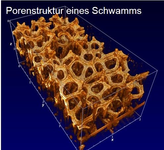Fully-automated detection of cerebral water content changes: study of age- and gender-related H2O patterns with quantitative MRI
NeuroImage. Bd. 29. H. 3. San Diego, Calif.: Elsevier [u.a.] 2006 S. 910 - 922
Erscheinungsjahr: 2006
ISBN/ISSN: 1053-8119
Publikationstyp: Zeitschriftenaufsatz (Forschungsbericht)
Sprache: Englisch
| Geprüft | Bibliothek |
Inhaltszusammenfassung
We present a simple and robust method for the automated image analysis of quantitative cerebral water content maps acquired with MRI. The method is based on a new approach for the absolute and quantitative mapping of water content in vivo. Water content maps were automatically segmented into grey and white matter by employing the quantitative T1 information acquired as part of the water content mapping procedure. Based on the segmented maps, twenty-two parameters sensitive to both absolute wa...We present a simple and robust method for the automated image analysis of quantitative cerebral water content maps acquired with MRI. The method is based on a new approach for the absolute and quantitative mapping of water content in vivo. Water content maps were automatically segmented into grey and white matter by employing the quantitative T1 information acquired as part of the water content mapping procedure. Based on the segmented maps, twenty-two parameters sensitive to both absolute water content and its spatial organisation are automatically extracted without user interaction. The parameters include, amongst others, absolute water content in grey and white matter and spatial asymmetries of the cerebral water content distribution. Significant age- and gender-related changes in the parameters determined were observed in a study of forty-four healthy subjects. Most notably, the grey matter water content decreases at a rate of 0.034%/year for females between the 3rd and 8th decade of life, whilst a much stronger decrease is observed in males which sets in after the 5th decade of life. In addition, female grey matter water content is, on average, 1.2% higher than the respective male grey matter water content. In contrast to the heterogeneity observed in grey matter, no significant physiological variation was observed for white matter water content. In addition to absolute grey matter water content, characteristic age- and gender-specific variations were also observed in most of the other variables. To check the potential loss of information associated with the large reduction of the dimensionality of the dataset to 22 parameters only, the age and gender of each individual subject were predicted by employing robust linear discriminant analysis based on only the determined twenty-two variables. The median deviation between predicted and real age was 6.3 years resulting in a high correlation coefficient between both values (r = 0.69). Gender is correctly predicted in 68.2% of all cases which improves to 87.5% when age-dependent effects are first corrected, demonstrating the high information content present in the variables even though the dimension of the dataset was significantly reduced. These results form the baseline for future studies of cerebral pathology. The method presented is fully automated, robust and flexible, making it an ideal tool for routine application in both neuroscientific studies and clinical diagnosis based on the quantitative measurement of cerebral water content.» weiterlesen» einklappen
Klassifikation
DFG Fachgebiet:
Medizin
DDC Sachgruppe:
Medizin

